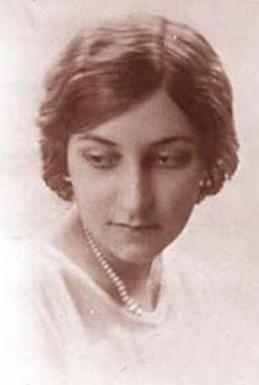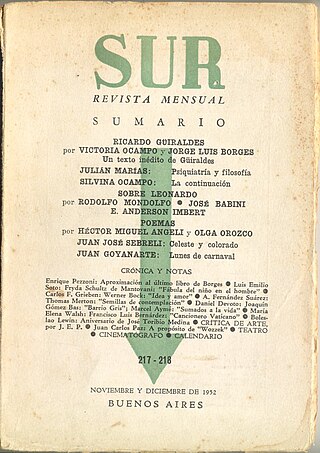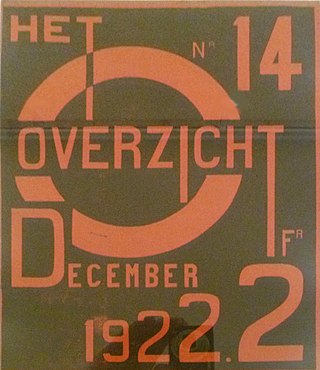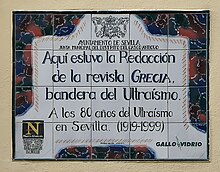
Ramón Gómez de la Serna y Puig, born in Madrid, was a Spanish writer, dramatist and avant-garde agitator. He strongly influenced surrealist film maker Luis Buñuel.

The Manifesto of Futurism is a manifesto written by the Italian poet Filippo Tommaso Marinetti, published in 1909. In it, Marinetti expresses an artistic philosophy called Futurism, which rejected the past and celebrated speed, machinery, violence, youth, and industry. The manifesto also advocated for the modernization and cultural rejuvenation of Italy.
The Florida group was an avant-garde literary-artistic group created in the 1920s in Buenos Aires, known by their embracing slogan "art for art's sake". The name refers to Florida Street, the location of a favored meeting point, the Richmond tea room.
Antonio Russolo (1877–1943) was an Italian Futurist composer and the brother of the more famous Futurist painter, composer and theorist Luigi Russolo. He is noted for composing pieces made with the intonarumori and, together with his brother, introduced The Art of Noises.

Leonor Fanny "Norah" Borges Acevedo, was an Argentine visual artist and art critic, member of the Florida group, and sister of the Argentine writer Jorge Luis Borges.

The Russian avant-garde was a large, influential wave of avant-garde modern art that flourished in the Russian Empire and the Soviet Union, approximately from 1890 to 1930—although some have placed its beginning as early as 1850 and its end as late as 1960. The term covers many separate, but inextricably related, art movements that flourished at the time; including Suprematism, Constructivism, Russian Futurism, Cubo-Futurism, Zaum, Imaginism, and Neo-primitivism. In Ukraine, many of the artists who were born, grew up or were active in what is now Belarus and Ukraine, are also classified in the Ukrainian avant-garde.

Sur was a literary magazine published in Buenos Aires between 1931 and 1992.
The Ultraist movement was a literary movement born in Spain in 1918, with the declared intention of opposing Modernismo, which had dominated Spanish poetry since the end of the 19th century.

Alice Bailly was a Swiss avant-garde painter, known for her interpretations on cubism, fauvism, futurism, her wool paintings, and her participation in the Dada movement. In 1906, Bailly had settled in Paris where she befriended Juan Gris, Francis Picabia, and Marie Laurencin, avant-garde modernist painters who influenced her works and her later life.
Martín Fierro was an Argentine literary magazine which appeared from February 1924 to 1927. It was one of the leading avant-garde magazines in the country.

Guillermo de Torre Ballesteros was a Spanish essayist, poet and literary critic, a Dadaist and member of the Generation of '27. He is also notable as the brother-in-law of the Argentine writer Jorge Luis Borges.

Rafael Cansinos Asséns was a Spanish poet, novelist, essayist, literary critic and translator.

Het Overzicht was a Dutch language literary magazine published in Antwerp, Belgium, between 1921 and 1925. Until its cessation in 1925 it was the major avant-garde magazine in the country and published a total of 24 issues.
Nuori Voima is a Finnish literary and cultural magazine which has been published since 1908. It is headquartered in Helsinki, Finland. Both the magazine and its parent organization, Nuoren Voiman Liitto, are among the well-respected institutions in Finland.
Simplismo is a literary technique, influenced by unanimism, that was developed and employed by Peruvian poet Alberto Hidalgo in the mid-twentieth century. It emphasizes basicity in writing and asserts there is more to be said with less.
Revista de Occidente is a cultural magazine which has been in circulation since 1923 with some interruptions. It is based in Madrid, Spain, and is known for its founder, José Ortega y Gasset, a Spanish philosopher.
La Gaceta Literaria was a bimonthly avant-garde literary, arts and science magazine which appeared in Madrid, Spain, between 1927 and 1932. It is known for its leading contributors and editorial board members.
Prometeo was a monthly avant-garde magazine which existed between 1908 and 1912 in Madrid, Spain. The magazine was established by the avant-garde writer Javier Gómez de la Serna. Its subtitle was revista social y literaria.
Noi: Rivista d’arte futurista was an avant-garde magazine which adopted a futurist stance. It was published in Rome between 1917 and 1925. Its subtitle was Raccolta internazionale d’arte d’avanguardia.
Zwrotnica was an avant-garde magazine which was one of the significant publications in Poland. It appeared in Kraków in two periods: first between 1922 and 1923, and then between 1926 and 1927. Despite its short run, it is the first Polish avant-garde magazine that had an international audience.









